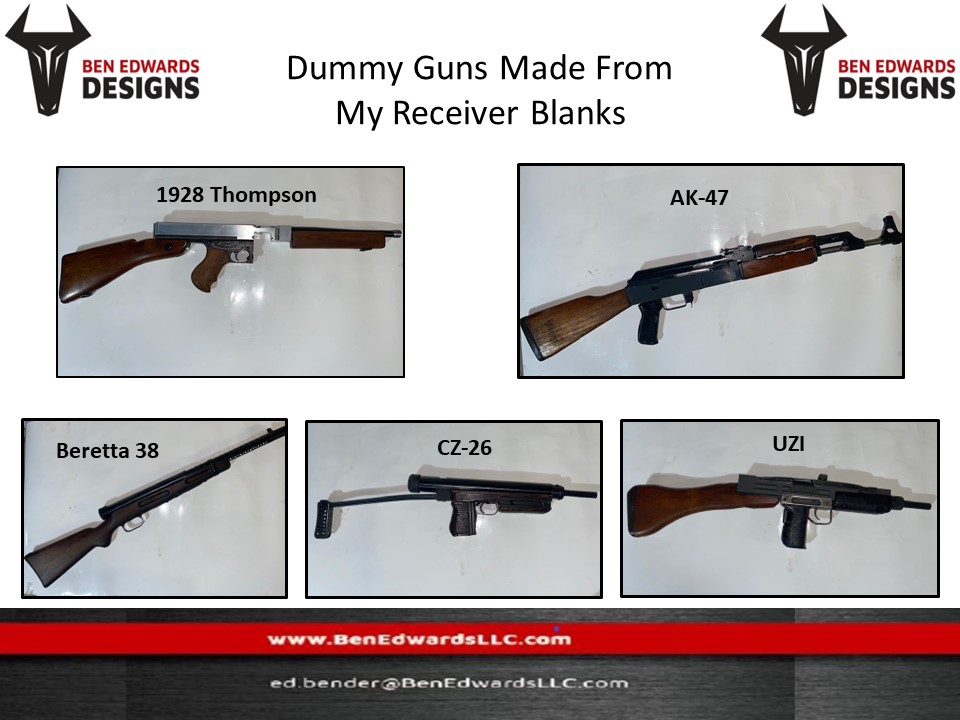Description
This is a 17-4 Stainless Steel 1911 A1 Government Frame Blank, no machining done. This frame is set for you to machine to completion. The sides have been Ground and Lapped for your convenience.
Ben Edwards Designs Product Catalog
Background
The U.S. military procured around 2.7 million M1911 and M1911A1 pistols during its service life. The pistol served as the standard-issue sidearm for the United States Armed Forces from 1911 to 1985. It was widely used in World War I, World War II, the Korean War, and the Vietnam War. The M1911A1 was replaced by the adoption of the 9mm Beretta M9 pistol as the standard U.S. military sidearm in 1985. However, the U.S. Army did not replace the M1911A1 with the Beretta M9 until October 1986, and due to the M1911’s popularity among users, it has not been completely phased out. Modernized derivative variants of the M1911 are still in use by some units of the U.S. Army Special Forces, U.S. Marine Corps and the U.S. Navy.
Technical Information
| Designer | John Browning |
| Designed | 1911 (Model 1911) |
| 1924 (Model 1911A1) | |
| Manufacturer | Colt Manufacturing Company |
| Unit cost | $26.38 (1938) equal to $508 now |
| Produced | 1911–present |
| No. built | 2,734,345 (produced by Colt) |
| 4,294,345 (total including licensed copies) | |
| Variants | M1911A1 |
| M1911A2 | |
| FN Grand Browning | |
| RIA Officers | |
| Kongsberg Colt | |
| MEU(SOC) pistol | |
| Specifications | |
| Mass | 39 oz (1,100 g) empty, with magazine |
| Length | 8.5 in (216 mm) |
| Barrel length | Government model: 5.03 in (127 mm) |
| Commander model: 4.25 in (108 mm) | |
| Officer model: 3.5 in (89 mm) | |
| Cartridge | .45 ACP |
| Action | Short recoil operation |
| Muzzle velocity | 830 ft/s (253 m/s) |
| Effective firing range | 50 m (160 ft) |
| Feed system | 7-round or 8-round (.45 ACP) box magazine |
Design details and accessories
Browning’s basic M1911 design has seen very little change throughout its production life. The basic principle of the pistol is recoil operation. As the expanding combustion gases force the bullet down the barrel, they give reverse momentum to the slide and barrel which are locked together during this portion of the firing cycle. After the bullet has left the barrel, the slide and barrel continue rearward a short distance.
At this point, a link pivots the rear of the barrel down, out of locking recesses in the slide, and the barrel is stopped by making contact with the lower barrel lugs against the frame. As the slide continues rearward, a claw extractor pulls the spent casing from the firing chamber and an ejector strikes the rear of the case, pivoting it out and away from the pistol through the ejection port. The slide stops its rearward motion then, and is propelled forward again by the recoil spring to strip a fresh cartridge from the magazine and feed it into the firing chamber. At the forward end of its travel, the slide locks into the barrel and is ready to fire again. However, if the fired round was the last round in the magazine, the slide will lock in the rearward position, which notifies the shooter to reload by ejecting the empty magazine and inserting a loaded magazine, and facilitates (by being rearwards) reloading the chamber, which is accomplished by either pulling the slide back slightly and releasing, or by pushing down on the slide stop, which releases the slide to move forward under spring pressure, strip a fresh cartridge from the magazine and feed it into the firing chamber.
There are no fasteners of any type in the 1911 design, besides the grip screws. The main components of the gun are held in place by the force of the main spring. The pistol can be “field stripped” by partially retracting the slide, removing the slide stop, and subsequently removing the barrel bushing. Full disassembly (and subsequent reassembly) of the pistol to its component parts can be accomplished using several manually removed components as tools to complete the disassembly.
The military mandated a grip safety and a manual safety. A grip safety, sear disconnect, slide stop, half cock position, and manual safety (located on the left rear of the frame) are on all standard M1911A1s. Several companies have developed a firing pin block safety. Colt’s 80 series uses a trigger operated one and several other manufacturers, including Kimber and Smith & Wesson, use a Swartz firing-pin safety, which is operated by the grip safety. Language cautioning against pulling the trigger with the second finger was included in the initial M1911 manual and later manuals up to the 1940s.
The same basic design has been offered commercially and has been used by other militaries. In addition to the .45 ACP (Automatic Colt Pistol), models chambered for .38 Super, 9×19mm Parabellum, 7.65mm Parabellum, 9mm Steyr, .400 Corbon, and other cartridges were offered. The M1911 was developed from earlier Colt semi-automatic designs, firing rounds such as .38 ACP. The design beat out many other contenders during the government’s selection period, during the late 1890s and early 1900s, up to the pistol’s adoption. The M1911 officially replaced a range of revolvers and pistols across branches of the U.S. armed forces, though a number of other designs have seen use in certain niches.






Dave B –
Great casting. The right dimensions in all the critical areas. good surface finish on all the places that will be left as cast.